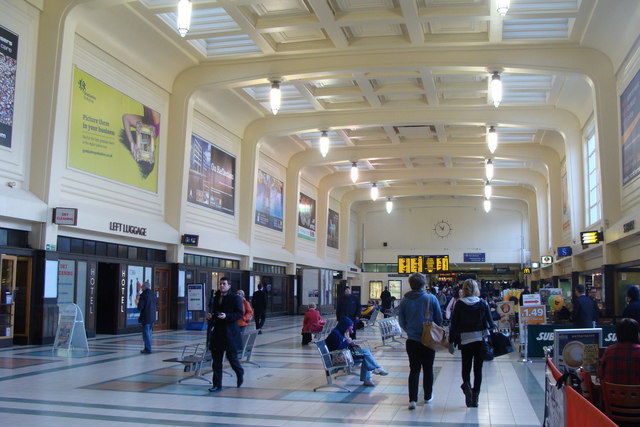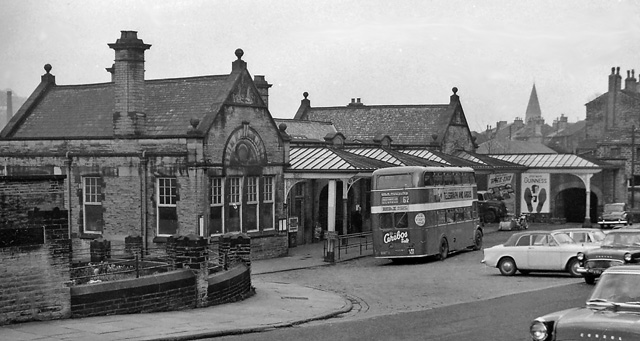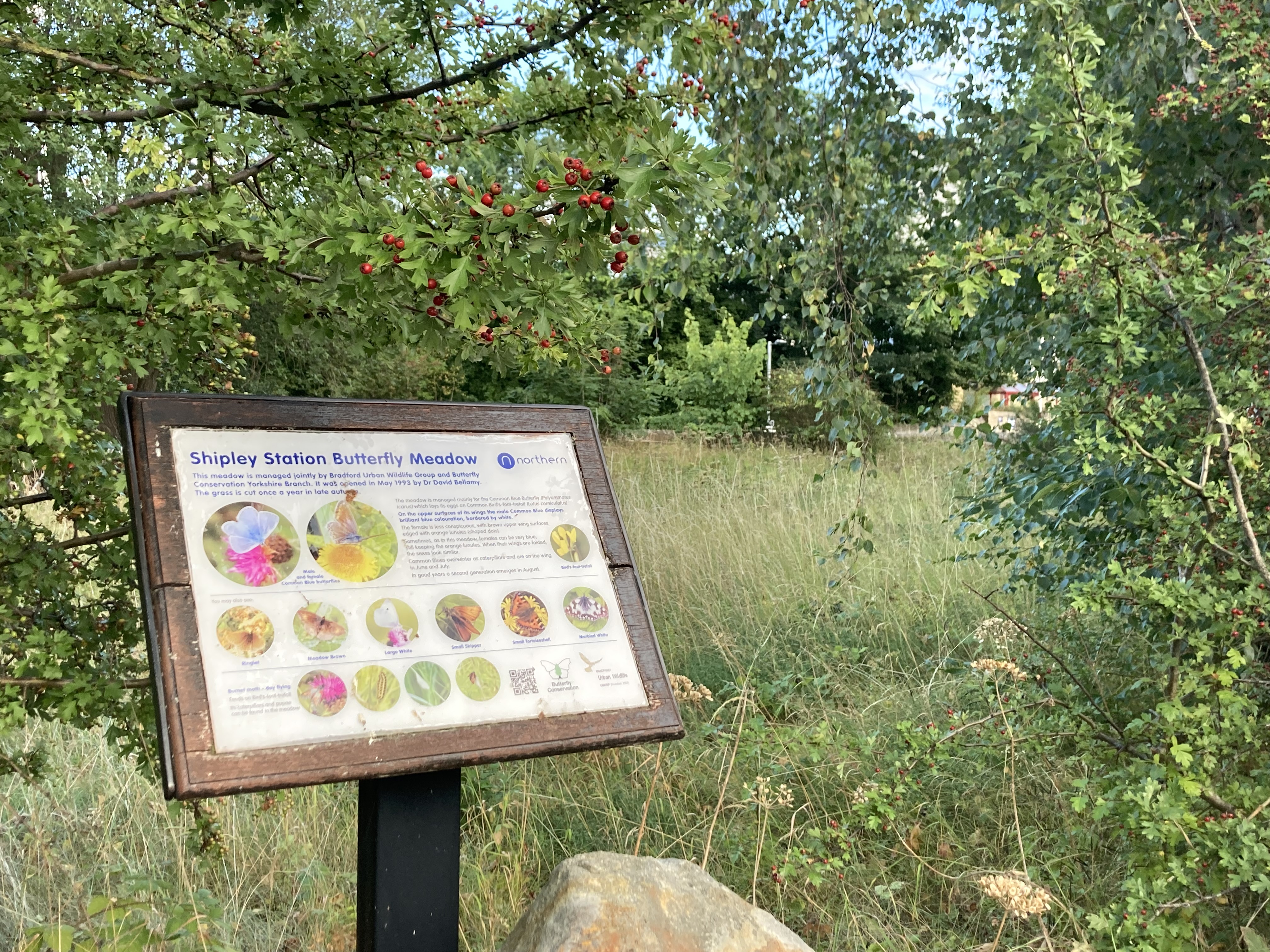|
Saltaire Railway Station
Saltaire railway station serves the village of Saltaire near Shipley in West Yorkshire, England. It is situated north of . History The original station was opened in May 1856 by the Midland Railway, which had absorbed the Leeds and Bradford Extension Railway between Shipley and Colne in 1851. It closed on 20 March 1965 following the Beeching Axe, but West Yorkshire Passenger Transport Executive and British Rail reopened it on 9 April 1984, at a cost of £139,000 (). The current station has wooden platforms and waiting shelters (though these are stone-built rather than the metal and plexiglass designs used elsewhere). Its predecessor was of more substantial stone construction, with buildings on each platform; these were demolished in 1970, five years after the station closed. The station is on the Airedale line, between Bradford and Leeds, and . It is a busy commuter station both for passengers travelling to Leeds and Bradford and for staff in companies based in Salt's Mi ... [...More Info...] [...Related Items...] OR: [Wikipedia] [Google] [Baidu] |
Saltaire
Saltaire is a Victorian era, Victorian model village in Shipley, West Yorkshire, Shipley, part of the City of Bradford Metropolitan District, in West Yorkshire, England. The Victorian era Salt's Mill and associated residential district located by the River Aire and Leeds and Liverpool Canal is a designated UNESCO World Heritage Site and an Anchor Point of the European Route of Industrial Heritage. History Saltaire was built in 1851 by Titus Salt, Sir Titus Salt, a leading industrialist in the Yorkshire woollen industry. The name of the village is a combination of the founder's surname and the name of the river. Salt moved his business (five separate mills) from Bradford to this site near Shipley, West Yorkshire, Shipley to arrange his workers and to site his large textile mill by the Leeds and Liverpool Canal and the railway. Salt employed the local architects Henry Francis Lockwood, Francis Lockwood and William Mawson. Similar, but considerably smaller, projects had also b ... [...More Info...] [...Related Items...] OR: [Wikipedia] [Google] [Baidu] |
Leeds City Railway Station
Leeds railway station (also known as Leeds City railway station) is the mainline railway station serving the city centre of Leeds in West Yorkshire, England. It is the fourth-busiest railway station in the UK outside London (as of March 2020). It is located on New Station Street to the south of City Square, at the foot of Park Row, behind the landmark Queens Hotel. It is one of 20 stations managed by Network Rail. Leeds is an important hub on the British rail network. The station is the terminus of the Leeds branch of the East Coast Main Line (on which London North Eastern Railway provides high speed inter-city services to every half hour from the station) and is an important stop on the Cross Country Route between Scotland, the Midlands and South West England connecting to major cities such as Birmingham, Glasgow, Edinburgh, Derby, Bristol, Exeter, Plymouth and Penzance. There are also regular inter-city services to major destinations throughout Northern England includin ... [...More Info...] [...Related Items...] OR: [Wikipedia] [Google] [Baidu] |
British Rail Class 333
The British Rail Class 333 are electric multiple unit passenger trains built by CAF between 2000 and 2003 for Northern Spirit (later Arriva Trains Northern), with traction equipment supplied by Siemens Transportation Systems. All have passed to subsequent franchises and subsequent operators Northern Rail, Arriva Rail North and Northern Trains. History In March 1998, Angel Trains ordered 16 three-carriage sets from Siemens Transportation Systems for Northern Spirit to replace the slam-door Class 308s on the Airedale and Wharfedale lines from Leeds to Bradford Forster Square, Ilkley and Skipton. Construction of the trains was sub-contracted to CAF with Siemens Transportation Systems providing the traction equipment. The first was delivered to Neville Hill TMD in March 2000. The first entered service on 12 January 2001. In April 2000, a further eight trailer carriages were ordered with funding from West Yorkshire Passenger Transport Executive and inserted into the first ei ... [...More Info...] [...Related Items...] OR: [Wikipedia] [Google] [Baidu] |
Bingley Railway Station
Bingley railway station is a grade II listed railway station that serves the town of Bingley in West Yorkshire, England, and is away from Leeds and away from Bradford Forster Square on the Airedale line operated by Northern Trains. History The Leeds and Bradford Railway opened the Leeds and Bradford Extension Railway from Shipley to Keighley on 16 March 1847. Bingley station opened on the first day, and remained the only intermediate station until Saltaire was built in 1856. The original station was near the Three Rise Locks on the Leeds and Liverpool Canal, but the Midland Railway (who had absorbed the L&BR in 1851) closed the old station and opened the current station on 24 July 1892. The second station was designed by Charles Trubshaw, who was a Midland Railway architect. The goods yard and accompanying shed, were located to the north of the station on the down side of the running lines. The shed, which is now in private hands, was taken out of railway use in 1965 ... [...More Info...] [...Related Items...] OR: [Wikipedia] [Google] [Baidu] |
Shipley Railway Station
Shipley railway station serves the market town of Shipley in West Yorkshire, England. It is north of and northwest of . Train services are mostly commuter services between Leeds and Bradford, the Airedale line (Leeds and Bradford to Skipton, via Keighley), and the Wharfedale Line (Leeds and Bradford to Ilkley). There are also a few main-line London North Eastern Railway services between Bradford or Skipton and London, and it also lies on the line from Leeds to Glasgow via the Settle-Carlisle Railway. History When the Leeds and Bradford Railway built the first railway link into Bradford in 1846, they did not take the shortest route, but a flatter and slightly longer one up Airedale to Shipley then south along Bradford Dale to Bradford. They built stations at several places along the route, including Shipley, which opened in July 1846. In 1847, the Leeds and Bradford Extension Railway was built from Shipley to Keighley and Skipton, creating the triangle of lines which s ... [...More Info...] [...Related Items...] OR: [Wikipedia] [Google] [Baidu] |
Leeds
Leeds () is a city and the administrative centre of the City of Leeds district in West Yorkshire, England. It is built around the River Aire and is in the eastern foothills of the Pennines. It is also the third-largest settlement (by population) in England, after London and Birmingham. The city was a small manorial borough in the 13th century and a market town in the 16th century. It expanded by becoming a major production centre, including of carbonated water where it was invented in the 1760s, and trading centre (mainly with wool) for the 17th and 18th centuries. It was a major mill town during the Industrial Revolution. It was also known for its flax industry, iron foundries, engineering and printing, as well as shopping, with several surviving Victorian era arcades, such as Kirkgate Market. City status was awarded in 1893, a populous urban centre formed in the following century which absorbed surrounding villages and overtook the nearby York population. It is locate ... [...More Info...] [...Related Items...] OR: [Wikipedia] [Google] [Baidu] |
Roberts Park, Saltaire
Roberts Park is a public urban park in Saltaire, West Yorkshire, England. Higher Coach Road, Baildon, is to the north and the park is bounded to the south by the River Aire. A pedestrian footbridge crosses the Aire and links the park to the village of Saltaire. The park is an integral part of the Saltaire World Heritage site. The park is grade II listed in English Heritage's Register of Parks and Gardens and is a Green Flag Award winner. Visitor numbers are estimated to be up to 3,000 people per day. History The park was designed and laid out by William Gay (1814–1893) for Sir Titus Salt (1803–1876) and was opened on 25 July 1871 by Sir Titus,; although conceived of as early as 1850. The park was named Saltaire Park but was known informally as The People's Park, and Salt's Park. The development included a widening and deepening of the River Aire for boating and swimming purposes, and for the construction of a boathouse on the southern bank of the river. In ... [...More Info...] [...Related Items...] OR: [Wikipedia] [Google] [Baidu] |
River Aire
The River Aire is a major river in Yorkshire, England, in length. The ''Handbook for Leeds and Airedale'' (1890) notes that the distance from Malham to Howden is direct, but the river's meanderings extend that to . Between Malham Tarn and Airmyn, the river drops . Part of the river below Leeds is canalised, and is known as the Aire and Calder Navigation. Course The Aire starts at Malham Tarn and becomes a subterranean stream at 'Water Sinks' about one mile (1.6 km) before the top of Malham Cove, it then flows underground to Aire Head, just below Malham, in North Yorkshire, and then flows through Gargrave and Skipton. After Cononley, the river enters West Yorkshire where it passes through the former industrial areas of Keighley, Bingley, Saltaire and Shipley. It then passes through Leeds and on to Swillington and Woodlesford. At Castleford is the confluence of the Aire and Calder; just downstream of the confluence was the ford where the ancient British road, used by t ... [...More Info...] [...Related Items...] OR: [Wikipedia] [Google] [Baidu] |
Leeds And Liverpool Canal
The Leeds and Liverpool Canal is a canal in Northern England, linking the cities of Leeds and Liverpool. Over a distance of , crossing the Pennines, and including 91 locks on the main line. The Leeds and Liverpool Canal has several small branches, and in the early 21st century a new link was constructed into the Liverpool docks system. History Background In the mid-18th century the growing towns of Yorkshire, including Leeds, Wakefield and Bradford, were trading increasingly. While the Aire and Calder Navigation improved links to the east for Leeds, links to the west were limited. Bradford merchants wanted to increase the supply of limestone to make lime for mortar and agriculture using coal from Bradford's collieries and to transport textiles to the Port of Liverpool. On the west coast, traders in the busy port of Liverpool wanted a cheap supply of coal for their shipping and manufacturing businesses and to tap the output from the industrial regions of Lancashire. Inspired by ... [...More Info...] [...Related Items...] OR: [Wikipedia] [Google] [Baidu] |
Shipley Glen Tramway
The Shipley Glen Tramway is a historic funicular tramway located in the wooded Shipley Glen near the village of Saltaire in the English county of West Yorkshire. The lower station of the funicular is some by foot from Saltaire railway station, and a similar distance from the historic Salts Mill, now occupied by shops and restaurants as well as the David Hockney gallery. Operation The line is operated by volunteer staff on behalf of a charitable trust, Shipley Glen Tramway Preservation Co Ltd. History The line was opened on 18 May 1895 by Sam Wilson, a local publican, showman and entrepreneur. It was intended to ease access to a number of other, now long closed, attractions at Shipley Glen, including a wooden toboggan ride and a massive fairground. As built, the line was powered by a gas engine. Since 1920 the line has been electrically operated. In 2002, operation of the line was taken over by a charitable trust under a lease from Bradford City Council. The tramway w ... [...More Info...] [...Related Items...] OR: [Wikipedia] [Google] [Baidu] |
World Heritage Site
A World Heritage Site is a landmark or area with legal protection by an international convention administered by the United Nations Educational, Scientific and Cultural Organization (UNESCO). World Heritage Sites are designated by UNESCO for having cultural, historical, scientific or other form of significance. The sites are judged to contain " cultural and natural heritage around the world considered to be of outstanding value to humanity". To be selected, a World Heritage Site must be a somehow unique landmark which is geographically and historically identifiable and has special cultural or physical significance. For example, World Heritage Sites might be ancient ruins or historical structures, buildings, cities, deserts, forests, islands, lakes, monuments, mountains, or wilderness areas. A World Heritage Site may signify a remarkable accomplishment of humanity, and serve as evidence of our intellectual history on the planet, or it might be a place of great natural beauty. A ... [...More Info...] [...Related Items...] OR: [Wikipedia] [Google] [Baidu] |




.jpg)
